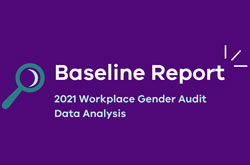Dr Niki Vincent* details the findings of her audit into gender equality in the Victorian Public Service.
 You can’t manage what you don’t measure and you can’t fix what you can’t see.
You can’t manage what you don’t measure and you can’t fix what you can’t see.
And what is clear for everyone to see reading the results of Australia’s first gender equality audit in the public sector is that women have a long way to go to achieve genuine equality.
No surprise there, but for the first time we now have the most comprehensive data on which to make evidence-based decisions to finally fix the problem.
Around 300 of Victoria’s public sector organisations employing more than 450,000 workers in total participated in Australia’s first mandatory workplace gender equality audit.
Under the landmark Gender Equality Act, all state government departments and authorities, emergency services, councils and universities must measure workplace gender inequality to make improvements.
The report we released this week found that the average pay gap between men and women was 15.6 per cent.
This means that, on average, men took home $19,000 more than women across the 2020-21 financial year.
In comparison, in the private sector, Australia’s national gender pay gap was 22.8 per cent or $25,792 as calculated by the Workplace Gender Equality Agency.
Women’s participation in the paid Victorian workforce increased substantially over the past 5 decades, rising from 43.8 per cent in 1978 to 62.3 per cent in June 2022.
But as the data shows, workplaces still reflect the fact that the world of paid work was designed for men.
These findings are captured in our Baseline report, which also found:
- Women were significantly overrepresented in part-time and casual work, with 42 per cent of women working part time, compared to 15 per cent of men.
- More than three-quarters of workers using formal flexible work arrangements were women.
- Almost 8 out of 10 parental leave takers were women, and their leave lasted an average of 8 times longer than men’s.
- Women were 50 per cent more likely to say they experienced sexual harassment than men but they rarely made a formal complaint about this.
- Sexual harassment occurred most frequently in majority-men and frontline sectors, such as transport and police and emergency services.
- The gender composition of governing bodies across defined entities overall was largely balanced between women and men.
- Victorian Government targets in place since 2015 requiring 50 per cent of new government board appointments to be women have been successful in generating greater gender balance in public boards in Victoria.
The audit results for every organisation have been published on our publicly accessible portal and while I am sure this has caused some discomfort, the aim is not to name and shame but to make each organisation publicly accountable for making progress towards equality.
The fact that more than 97 per cent of workplace gender audits are compliant, and 100 per cent of the gender equality action plans are compliant proves there is a real commitment and that change is in the air.
The data also disproves the claim from some that the gender equality pendulum has swung too far and men are now the victims.
Despite some men claiming they are more likely to be discriminated against in promotions, men still make up the majority in leadership.
Despite women making up 66 per cent of employees in the public sector workforce, they make up only 45 per cent of those in senior leadership roles and more than 3 in 5 chief executives were men.
The baseline report shows Victoria’s public sector organisations are performing well in comparison to the private sector in some areas – and while there is still much progress to be made, there is a real appetite for change.
Addressing workplace gender inequality will lead to improved outcomes for women’s economic security, workforce participation and health and wellbeing, as well as overall national growth and economic productivity.
But this is more than simply reporting data.
Organisations must now act on the information by implementing Gender Equality Action Plans and reporting on their progress every two years.
I am proud to say we now have more transparency than ever before to understand the state and nature of gender inequality impacting a large component of Victoria’s workforce and I am confident that Victoria will continue to lead by example in addressing the systemic drivers of gender inequality within the workforce.
*Dr Niki Vincent is the Commissioner for Gender Equality in the Victorian Public Sector.
This article first appeared at broadagenda.com.au.











